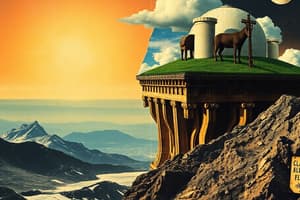Podcast
Questions and Answers
Which of the following best describes the key difference between climate and weather?
Which of the following best describes the key difference between climate and weather?
- Weather is the average of atmospheric conditions over a long period, while climate is the instantaneous state.
- Weather includes only temperature and precipitation, while climate includes all atmospheric variables.
- Climate refers to short-term atmospheric conditions, while weather describes long-term patterns.
- Climate is the long-term average of weather conditions, while weather is the short-term state of the atmosphere. (correct)
During a La Niña event, what ocean condition is most likely to occur in the central and eastern equatorial Pacific Ocean, and how does this affect global weather patterns?
During a La Niña event, what ocean condition is most likely to occur in the central and eastern equatorial Pacific Ocean, and how does this affect global weather patterns?
- Warmer than average sea surface temperatures, causing increased rainfall in South America and drought in Australia.
- Colder than average sea surface temperatures, leading to increased rainfall in South America causing flooding in Australia.
- Colder than average sea surface temperatures, causing increased rainfall in Southeast Asia and drier conditions in South America. (correct)
- Warmer than average sea surface temperatures, leading to increased rainfall in Southeast Asia and drier conditions in South America.
Which of the following scenarios best illustrates the impact of Milankovitch cycles on Earth's climate?
Which of the following scenarios best illustrates the impact of Milankovitch cycles on Earth's climate?
- Long-term variations in Earth's orbit and axial tilt, causing cycles of glacial and interglacial periods. (correct)
- Daily temperature fluctuations caused by the Earth's rotation.
- Sudden increase in volcanic activity leading to a 'nuclear winter'.
- Increased solar flare activity resulting in short-term warming events.
Considering the sources of greenhouse gasses, which activity contributes the most to methane ($CH_4$) emissions?
Considering the sources of greenhouse gasses, which activity contributes the most to methane ($CH_4$) emissions?
How does a temperature inversion exacerbate air pollution problems in urban areas?
How does a temperature inversion exacerbate air pollution problems in urban areas?
Flashcards
Climate vs. Weather
Climate vs. Weather
Climate is long-term weather patterns, while weather is the current atmospheric condition.
Greenhouse Effect
Greenhouse Effect
A natural process where greenhouse gases trap heat in the atmosphere, warming the Earth.
Milankovitch cycles
Milankovitch cycles
Cycles in Earth's orbit affecting sunlight distribution and influencing long-term climate patterns.
Main sources of greenhouse gasses
Main sources of greenhouse gasses
Signup and view all the flashcards
Primary Pollutants
Primary Pollutants
Signup and view all the flashcards
Study Notes
- Climate differs from weather, climate is long-term atmospheric conditions, whereas weather is short-term atmospheric conditions.
Layers of the Atmosphere
- Troposphere: This is the is the lowest layer where weather occurs.
- Stratosphere: This layer contains the ozone layer that absorbs UV radiation.
- Mesosphere: This is the layer where meteors burn up.
- Thermosphere: This is the highest layer where auroras occur.
El Nino and La Nina
- El Nino: Warmer than average sea surface temperatures in the central and eastern tropical Pacific Ocean.
- La Nina: Cooler than average sea surface temperatures in the central and eastern tropical Pacific Ocean.
- Change from one to another is caused by changes in wind patterns and ocean currents.
Greenhouse Effect
- The process involves greenhouse gases trapping heat in the Earth's atmosphere.
- Benefits are that it keeps the Earth warm enough to support life.
Milankovitch Cycles
- Milankovitch cycles are variations in Earth's orbit and tilt that affect the amount of solar radiation reaching the Earth.
- These cycles and other natural processes such as volcanic eruptions affect the climate.
Anthropogenic Global Climate Change
- Scientific support includes rising global temperatures, melting glaciers and ice sheets.
- Additionally changes in precipitation patterns, and increasing ocean acidity all support the theory.
Sources of Greenhouse Gasses
- Burning fossil fuels produces carbon dioxide.
- Agriculture produces methane and nitrous oxide.
- Deforestation reduces carbon sinks.
Political Steps
- Rio Earth Summit: A UN conference held in Rio de Janeiro in 1992, promoted sustainable development.
- Kyoto Protocol: An international treaty adopted in 1997, committed developed countries to reduce greenhouse gas emissions.
- Paris Agreement: An agreement adopted in 2015, aims to limit global warming to well below 2 degrees Celsius.
- Since the protocol went into effect, political steps have been taken such as the development of renewable energy technologies and the implementation of carbon pricing mechanisms.
Measures To Reduce Greenhouse Emissions
- Switching to renewable energy sources
- Improving energy efficiency
- Implementing carbon capture and storage technologies
- Reducing deforestation
Natural Sources of Air Pollution
- Volcanic eruptions emit ash and gases.
- Wildfires release smoke and particulate matter.
- Dust storms carry dust and sand.
Primary and Secondary Pollutants
- Primary pollutants are emitted directly from a source.
- Secondary pollutants form in the atmosphere through chemical reactions.
Criteria Pollutants
- The Clean Air Act of 1970 identifies six criteria pollutants
- These are: particulate matter, sulfur dioxide, nitrogen dioxide, carbon monoxide, ozone, and lead.
- Particulate matter: tiny particles that can be inhaled and cause respiratory problems.
- Sulfur dioxide: a gas that can cause respiratory problems and acid rain.
- Nitrogen dioxide: a gas that can cause respiratory problems and contribute to smog and acid rain.
- Carbon monoxide: a gas that can reduce the ability of blood to carry oxygen.
- Ozone: a gas that can cause respiratory problems and damage vegetation.
- Lead: a metal that can accumulate in the body and cause neurological damage.
Temperature Inversion and Long Range Transport
- Temperature inversion traps pollutants near the ground.
- Long range transport carries pollutants over long distances.
CFC’s
- CFCs break down ozone molecules in the stratosphere.
- This allows harmful UV rays to reach the Earth's surface.
Air Pollution Effects
- Air pollution can cause respiratory problems, cardiovascular problems, and cancer in humans.
- Air pollution can damage vegetation, reduce crop yields, and disrupt ecosystems.
Acid Deposition
- Acid deposition acidifies lakes and streams, harming aquatic life.
- Acid deposition damages forests, making them more susceptible to disease and pests.
Methods Being Used to Decrease Air Pollution
- Installing scrubbers on smokestacks
- Using catalytic converters on vehicles
- Switching to cleaner fuels
- Implementing stricter emission standards
Target Pollutants
- The Clean Air Act initially focused on criteria pollutants.
- Over time, the focus has shifted to include other pollutants such as air toxics and greenhouse gases.
Studying That Suits You
Use AI to generate personalized quizzes and flashcards to suit your learning preferences.




